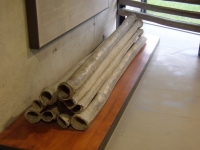
6. Running Water
Was there always running water in aqueducts?Here a set of questions with relevant answers, some of which are linked to related subjects as discussed in other places within this website www.romanaqueducts.info
Additional questions or remarks are most welcome via w.d.schram 'at' romanaqueducts.info
Questions
- Was there always running water in the aqueducts?
- Did aqueduct water always run downwards?
- Why did the Romans used lead for aqueducts?
- When lead pipes were used, why were the Romans not poisoned?
Answer
Because of lack of maintenance there were many leaks in Roman aqueducts so the water was not always running inside the aqueduct. And what do you think about illegal tapping of the aqueducts water: read the descriptions of the Curator Aquarum Sextus Julius Frontinus, the water manager of the aqueducts of Rome.In general the water was running, even all day and night, unlike our modern systems with pumps, water towers, taps and stopcocks. There were, however, stopcocks in many places inside the Roman empire. These were solely applied in urban settings.
The surplus water of the public fountains was used to flush the public toilets and the drains, or sold to local industries.
Within the cities the aqueduct water was distributed via a so-called castellum divisorium (distribution basin) in lead pipes.
The Romans did know that lead was toxic; that is why the ancient architect Vitruvius was in favor of terracotta pipes. Nevertheless the Romans did not die in great numbers because of lead poisoning: the whole system was based on constant running water so the contact with lead was minimal. On top of that the water was, in most cases, calcareous which resulted in a layer of so-called sinter in channels and pipes, protecting the users.
In principle the water always ran downwards because the aqueducts were gravity driven. Exceptions to this are where water was put under pressure i.e. in a piped aqueduct or in siphons.